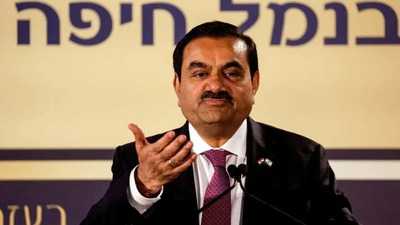The Washington Post–LIC–Adani controversy has evolved into one of the most high-profile financial and political debates of the year, raising questions about institutional independence and the intersection of public funds and private conglomerates.
The Washington Post’s investigative reportThe controversy began after The Washington Post published an investigative article on October 24, 2025, alleging that the Indian government directed a plan to channel nearly $3.9 billion (around Rs 33,000 crore) from the Life Insurance Corporation of India (LIC) into the Adani Group.
The story claimed to rely on internal documents and interviews with officials from the Department of Financial Services (DFS), NITI Aayog, and LIC itself. According to the report, these agencies “crafted and approved” the investment proposal in May 2025, describing it as part of a larger strategy to support Gautam Adani’s businesses, which were still dealing with reputational and financial fallout from the 2023 Hindenburg report.
Citing unnamed officials and alleged documents, the report said the plan involved LIC making a major investment in Adani Ports and Special Economic Zone Ltd. through a bond issue worth approximately $585 million (Rs 5,000 crore).
The Post said internal communications lauded Adani as a “visionary entrepreneur” who had shown “remarkable resilience,” while acknowledging risks linked to his companies’ market volatility and global scrutiny.
This bond issue, announced in May, was entirely financed by LIC, which the paper portrayed as a sign of government influence on India’s largest insurer.
LIC rejects report as ‘false, baseless’LIC immediately rejected the report, calling it “false, baseless, and far from the truth.”
The insurer said no plan or directive existed from the Finance Ministry or DFS, and that its investments were made independently with board-approved due diligence procedures.
LIC insisted that Adani Ports’ debt instruments were AAA-rated and purchased on merit, adding that the Department of Financial Services “has no role in investment decisions.”
Indian govt’s responseLIC denies false reports by The Washington Post, reaffirming all investments are made with integrity and due diligence.#LIC #HarPalAapkeSaath #washingtonpost pic.twitter.com/RQ0N2AvBA1
— LIC India Forever (@LICIndiaForever) October 25, 2025
The Indian government also dismissed the Washington Post’s allegations. A top DFS official stated that “no letter was written to LIC” and that the department does not issue such directives to financial institutions.
Officials described the claims as “completely untrue” and said the documents cited by the newspaper did not originate from the ministry. The Adani Group, for its part, said the report was “misleading” and clarified that LIC’s investments were part of normal financial activity carried out across multiple corporate groups.
Political reactionsThe report, however, ignited strong political reactions across opposition lines.
The Congress Party called it a “disturbing revelation” and demanded that Parliament’s Public Accounts Committee (PAC) launch an inquiry into LIC’s investments in the Adani Group.
Congress spokesperson Jairam Ramesh questioned “under whose pressure” the Finance Ministry and NITI Aayog officials decided that their job was to bail out a private company facing allegations of corruption.”
Disturbing revelations have just emerged in the media about how the Modani joint venture systematically misused the Life Insurance Corporation of India (LIC) and the savings of its 30 crore policyholders.
— Congress (@INCIndia) October 25, 2025
Internal documents reveal that Indian officials drafted and pushed… pic.twitter.com/lI7gz66kWo
Congress president Mallikarjun Kharge wrote on X that the issue represented “a breach of public trust,” accusing the Modi government of using citizens’ insurance savings to “prop up corporate allies.”
He said the average policyholder “had no idea that their hard-earned savings were being used to bail out Adani,” and termed it “loot under the guise of economic nationalism.”
Direct Benefits Transfer की असली लाभार्थी भारत की आम जनता नहीं बल्कि मोदी जी के परम मित्र हैं।
— Mallikarjun Kharge (@kharge) October 25, 2025
क्या एक आम Salaried Middle Class व्यक्ति जो पाई-पाई जोड़कर LIC का Premium भरता है, उसे ये भी मालूम है कि मोदी जी उसकी ये जमा-पूंजी अडानी को Bailout करने में लगा रहें हैं? क्या ये… pic.twitter.com/ZYzbRRT1Py
Other opposition leaders joined the criticism. Trinamool Congress MP Mahua Moitra questioned LIC’s denial, asking,
“Sorry @LICIndiaForever what exactly is false? That you used Rs 30,000 crore of taxpayer money to bail out Adani?” Or that you asked @FinMinIndia to hurry up with approvals?
Aam Aadmi Party leader Manish Sisodia accused the government of “trading the trust of millions of policyholders to favour a single industrialist,” claiming the report exposed a pattern of cronyism.
Sorry @LICIndiaForever what exactly is false? That you used ₹30,000 crores of tax payer money to bail out Adani? Or that you asked @FinMinIndia to hurry up with approvals? https://t.co/hYiEHo52Xi
— Mahua Moitra (@MahuaMoitra) October 25, 2025
Get the latest updates in Hyderabad City News, Technology, Entertainment, Sports, Politics and Top Stories on WhatsApp & Telegram by subscribing to our channels. You can also download our app for Android and iOS.
You may also like

From Samastipur to Begusarai: Why PM Modi's Bihar campaign start is a calculated political move; the 36% swing math explained

Dani Dyer's Strictly Come Dancing return 'confirmed' after shock withdrawal

Prince Andrew promises King Charles he won't 'pull a Harry' with bombshell memoir

EAM Jaishankar wishes Austria on National Day, reaffirms commitment to advance partnership

The beautiful tiny UK village with cobbled streets that's best to visit before Christmas







